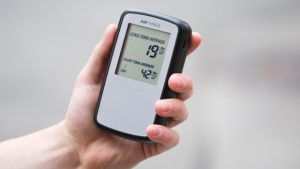Radon Test Kits available for loan from your public library
November is both Lung Awareness Month and Radon Awareness Month.
LANS (Lung Association of Nova Scotia), with funding from Health Canada, has partnered with public libraries across the province to offer radon test kits via your local library. Each regional library system in Nova Scotia has been provided with two kits for free public loan, complete with instructions and fact sheets. 
Here’s what the Lung Association of Nova Scotia tells us about radon:
“Radon is a radioactive gas produced naturally by the decay of uranium in the ground. It exists all over the world, although the amount of uranium and level of radon gas vary significantly, even from one house to the next. Radon is invisible, you can’t see it, smell or taste it and it can get into your home undetected.
The current Canadian Guideline for radon is 200 becquerels per cubic meter (Bq/m3). Becquerels per cubic meter is the unit of measurement for radon, the higher the number the greater the risk. Protecting your family’s health from the risk of radon exposure starts with learning more.
The only known risk from long-term exposure to radon is the development of lung cancer. Radon exposure is the 2nd leading cause of lung cancer after smoking. The level of risk depends on the concentration of radon as well as the number of years of exposure.
Radon in your home?
A recent study has shown that over 1 in 5 New Brunswick households have radon levels above the Canadian guideline- one of the highest in Canada. Radon is found in nearly all homes in Canada, new or old. The question is: how much is in your home? The gas can enter the home wherever it has contact with the ground. Radon tends to accumulate in the lower levels of the home, like the basement for example, where it can reach high concentrations.
The gas can seep into the house in a variety of places:
- Foundation wall cracks;
- Between floor tiles;
- Packed earth floors;
- Construction seams;
- Gaps around pipes and support posts;
- Crawl spaces, drains and sump holes.
The only way to know if you have a radon problem in your home is to measure its concentration with a simple test.”
For more information about radon and its detection, visit the LANS website here https://ns.lung.ca/lung-health/radon-gas
The radon test kits are now available for loan from your library, so get your name on what-may-be a wait list. You’ll need a library card (they’re free if you don’t already have one), and the kits can be loaned for 6 weeks – no renewals permitted. Please note that Health Canada’s protocol for radon testing recommends a test duration of not less than 1 month. These kits are directed at individual home residence use only, not for institutional settings.
In conjunction, but not necessary for use of the kit, there is a booklet for loan as well. Radon Reduction Guide for Canadians is a useful resource.
Disclaimer: This program is intended as an introduction to radon testing. Disclaimers are included in the kits. If library customers have questions about interpreting the results of their radon testing they should contact LANS.